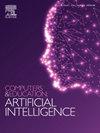ChatGMP: A case of AI chatbots in chemical engineering education towards the automation of repetitive tasks
Q1 Social Sciences
Computers and Education Artificial Intelligence
Pub Date : 2024-12-30
DOI:10.1016/j.caeai.2024.100354
引用次数: 0
Abstract
Artificial Intelligence (AI) is rapidly and consistently becoming more integrated in various aspects of our lives. One of the areas where these systems are increasingly used is education. In fact, it is both being incorporated into specific curricula, allowing students the possibility to acquire skills within this field, and more recently AI has been used as a tool to facilitate the teaching and learning process. However, an increased demand and availability of these tools do not imply a successful switch from traditional to AI-supported learning.
In this work, ChatGMP, a chatbot leveraging a Large Language Model (LLM) able to conduct an interview exercise in a Master's Degree course taught at the Technical University of Denmark (DTU), is introduced. The exercise consists in a student interview of a fictitious company, represented by the teachers or ChatGMP, regarding its Good Manufacturing Practices (GMP). The aim is for the students to ask sensible and well-reasoned questions to acquire the necessary documentation to make an exhaustive report indicating whether the company is a potential fit for business. To evaluate the initiative, we compare the performance of ChatGMP to the one of the physical teachers of the course, as well as the perception of the students towards it. The results show no significant difference in the information provided by the teachers and the model, enabling the students to achieve similar learning. The students that interacted with ChatGMP are satisfied with the initiative and would likely recommend future students to perform the audit with the digital tool. This initial experiment and its positive results lay the foundation for opening the discussion on how to use LLMs in education, the opportunities they could provide, as well as their limitations and drawbacks.
求助全文
约1分钟内获得全文
求助全文
来源期刊

Computers and Education Artificial Intelligence
Social Sciences-Education
CiteScore
16.80
自引率
0.00%
发文量
66
审稿时长
50 days
 求助内容:
求助内容: 应助结果提醒方式:
应助结果提醒方式:


